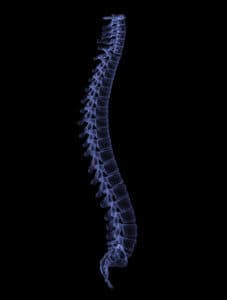Laurel physical therapists describe the typical approach for treating scoliosis

August 22, 2016
You may not know it, but the shape of your spine has a natural curve. If you were to look at it from the side, you would notice it actually looks something like the letter “S.” This type of vertical curvature is completely normal; however, if the spine curves to the side, it means scoliosis is present, which may lead to issues in the future.
Scoliosis is not a disease, but rather a term used to describe this abnormal sideways curvature of the spine. Viewed from the back, a typical spine will appear straight, but when scoliosis occurs, the spine can curve in one of three ways:
- It curves to the side as a single curve to the left (shaped like the letter “C”)
- It curves to the side as a single curve to the right (shaped like a backwards “C”)
- It has two curves (shaped like the letter “S,” not to be confused with normal curvature, which looks like an “S” from the side)
Scoliosis most typically occurs in individuals 10-18 years old and is often detected by school screenings or regular physician visits. During screenings, medical professionals look for abnormal curvature of the spine, uneven shoulders, asymmetry of waistline or one hip higher than the other. Idiopathic scoliosis, which means that it has no known cause, is the most common form overall (affecting 2% of the population) and the most common form in children. Patients with idiopathic scoliosis rarely experience pain and the curve is usually minor enough that treatment isn’t needed, but this can change with time.
Observation and treatment for scoliosis
Once scoliosis is detected, the most important thing is regular monitoring by one’s physician, who will keep track of the progress of the curvature. This is measured by the angle of the curvature: if there is mild curvature that remains at 20° or less, further treatment is usually not necessary beyond frequent monitoring and observation. If the curvature becomes greater than 20°, the patient may require either surgical or non-surgical treatment.
The primary goal of scoliosis treatment is to prevent severe curvature of the spine, which can affect the physical appearance and health of the patient, and possibly lead to long-term issues if the curvature is great enough. Treatments will differ based on the degree of curvature and other factors, but two of the more common treatments are back braces and surgery, both of which prevent further progression of the spine.
Physical therapy may be used to treat scoliosis in some cases as well. Treatment from our Laurel physical therapists typically consists of exercises, manipulation, insoles/orthotics and the use of an electrical stimulation machine. Your physical therapist will also educate you about scoliosis to ensure that you completely understand your condition.
Unfortunately, there are no guarantees with scoliosis treatment, and the smartest approach is to carefully monitor it and take action when needed. If your child has scoliosis or you are dealing with some other condition, CAM Physical Therapy and Wellness Services in Laurel, Hyattsville, Glenn Dale/Bowie and Parkville, MD can help. Call us at 301-853-0093 for more information or to schedule an appointment today.